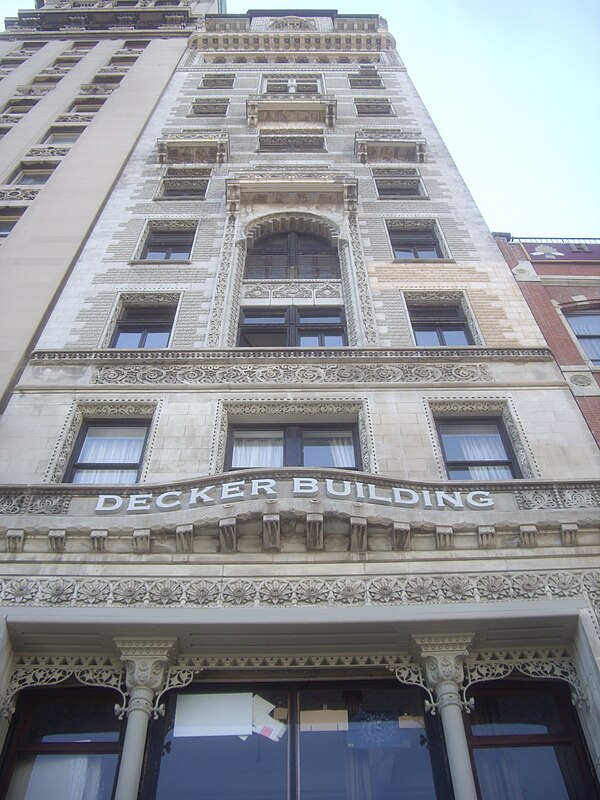Decker Building
Commercial building in Manhattan, New York From Wikipedia, the free encyclopedia
The Decker Building (also the Union Building) is a commercial building located at 33 Union Square West in Manhattan, New York City. The structure was completed in 1892 for the Decker Brothers piano company, and designed by John H. Edelmann.[2] From 1968 to 1973, it served as the location of the artist Andy Warhol's studio, The Factory.[3] The Decker Building was designated a New York City landmark in 1988, and was added to the National Register of Historic Places in 2003.
Decker Building | |
 Decker Building | |
 | |
| Location | 33 Union Square West, New York, New York |
|---|---|
| Coordinates | 40°44′12″N 73°59′27″W |
| Built | 1893 |
| Architect | John H. Edelmann |
| Architectural style | Late 19th and early 20th century American movements |
| NRHP reference No. | 03001179[1] |
| NYCL No. | 1538 |
| Significant dates | |
| Added to NRHP | November 21, 2003 |
| Designated NYCL | July 12, 1988 |
Description
The building is only 33 feet (10 m) wide and 138 feet (42 m) deep on a lot that goes back 150 feet (46 m).[4] It has a right of way to 16th Street from the rear of the building. The style of the building mixes influences from Venice and Islamic traditions. There are numerous terra cotta details on the façade which remain today. There was a minaret on the roof which disappeared before World War II.
The building was valued at $285,000 in 1913, after which it was traded to settle debts.[5]
History
Summarize
Perspective
The structure was built in 1892 for the Decker Brothers piano company according to designs by the radical anarchist architect John H. Edelmann, working out of the offices of Alfred Zucker. It replaced the earlier Decker Building on the same lot, designed by Leopold Eidlitz and built in 1869.[2]
On November 25, 1950, 27 year old Abraham Yeager was killed when a one-ton piece of cornice from the Decker Building collapsed onto the sidewalk where Yeager was walking.[6]
Warhol years
In 1967, artist Andy Warhol had to move his Factory from East 47th Street after the previous building was torn down. Union Square at the time was a rundown neighborhood, but Paul Morrissey had found the loft, in the Decker Building, and Warhol agreed to move there. While Morrissey was stripping wood at the Factory, a young man named Jed Johnson delivered Western Union telegram in 1968. Morrissey hired him on the spot to help out with the refinishing of the space.[7] Johnson subsequently moved in with Warhol and became his longtime partner.[8]
On June 3, 1968, Valerie Solanas visited the Factory to look for Warhol, who she felt was taking control of her screenplay away from her. She then shot Warhol three times, seriously wounding him, as well as art critic and curator Mario Amaya.[9][3] The Factory previously had an open door policy, meaning that anybody could enter. However, following the shooting, Johnson installed a Dutch door and built a wall around the elevator, requiring guests to buzz in.[10]
Around 1970, Warhol had a video camera system built to tape his visitors and document the activities around the studio.[11] In 1973, Warhol moved the Factory to 860 Broadway, a short distance away, and created the Warhol Time Capsules while packing up.[12]
Refurbishment
The building was completely refurbished into apartments by Joseph Pell Lombardi in 1995.[13] In 2015, Dylan's Candy Bar opened a ground-floor storefront in the building,[14] which closed in 2021.[15]
See also
References
Wikiwand - on
Seamless Wikipedia browsing. On steroids.
